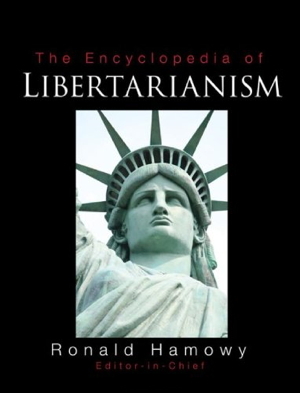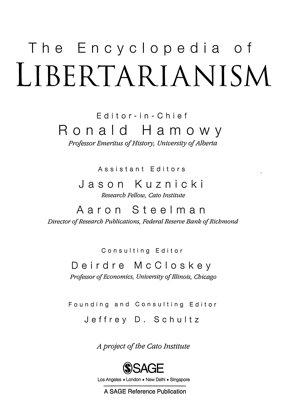
An outstanding resource for students and teachers of the classical liberal / libertarian tradition is the Cato Institute’s Encyclopedia of Libertarianism (2008) which, in its 600 pages of double-columned type, has articles on the key ideas, important figures, and historical movements of this tradition. After a very long wait it is available online.
The Encyclopedia of Libertarianism. Editor-in-Chief Ronald Hamowy. Assistant Editors Jason Kuznicki and Aaron Steelman. Consulting Editor Deirdre McCloskey. Founding and Consulting Editor Jeffrey D. Schultz. (Los Angeles: Sage, 2008. A Project of the Cato Institute).
My small contribution to the project was a series of 9 articles on French classical liberals which I have now put online at my own website. They are on:
- Comte, Charles (1782-1837),
- Condorcet, Marquis de (1743-1794),
- Constant, Benjamin (1767-1830),
- Dunoyer, Charles (1786-1862),
- French Revolution,
- Molinari, Gustave de (1819-1912),
- Say, Jean-Baptiste (1767-1832),
- Tracy, Destutt de (1754-1836), and
- Turgot, Anne-Robert-Jacques (1727-1781).
I thought the book provided such a good survey of the CL tradition in a compact and easily accessible form (except for the very high price of the physical book, before it went online and free of charge) that I designed a series of lectures I was asked to give on the history of the classical liberal tradition around readings taken from the Encyclopedia. My series of lectures needs to be rewritten and revised but here is the overall structure of them:
The Classical Liberal Tradition – A History Of Ideas And Movements Over 400 Years
- Introduction
- The Problem of Definition: Liberalism vs. Hyphenated Liberalism
- Is Liberalism “Left” or “Right”?
- The Relationship between Ideas, Interests, and Action
- Liberalism and the State
- The Problem of Class and Class Struggle
- The Problem of Revolution
- The Problem of Keeping the State Limited
- Why people obey the State?
- The Methodology used in this Paper
- I. Ideas
- What Liberals were For and what they were Against
- Twelve Key Concepts of Liberty
- II: Individuals, Movements, & Political Events
- The Pre-history of Liberalism
- The Four Main Periods of Liberal Activity/Reform
- 1640s: the English Civil War/Revolution
- 1750s-1790s: the American and French Revolutions
- the long liberal 19th century 1815-1914
- the post-WW2 liberal renaissance
- Key Thinkers (Texts), Politicians and Activists (Movements, Documents)
- III. Key Political Documents
- IV. Strategies to Achieve Liberal Reforms
- V. The Achievements and Failures of Liberalism
The reading for this series of lectures is listed here with links to the online version of the Encyclopedia for information on “Key Ideas” and “Key Movements and People”
Overview of “The Classical Liberal Tradition – A History Of Ideas And Movements Over 400 Years”
- A History of Classical Liberalism I: Twelve Key Concepts of Liberty (with “concept maps”)
- A History of Classical Liberalism II: The Ideological Movements & Key Political Events which made The Classical Liberal Tradition possible
- Quotations about Liberty & Power (from the classic texts)
The Classical Liberal Tradition – Readings from The Encyclopedia of Libertarianism

